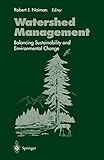Watershed management: balancing sustainability and environmental change [Libro electrónico] / editor Robert J. Naiman
Naiman, Robert J [editor].
Tipo de material: Libro
en línea Editor: New York: Springer-Verlag, c1992Descripción: xii, 542 páginas : ilustraciones ; 25 centímetros.ISBN: 0387977902; 9780387942322; 9781461243823.Tema(s): Watershed management -- Northwest, Pacific -- CongressesNota de acceso: Disponible para usuarios de ECOSUR con su clave de acceso Nota de bibliografía: Incluye bibliografía e índice: páginas 523-542 Número de sistema: 55019Resumen:
Libro
en línea Editor: New York: Springer-Verlag, c1992Descripción: xii, 542 páginas : ilustraciones ; 25 centímetros.ISBN: 0387977902; 9780387942322; 9781461243823.Tema(s): Watershed management -- Northwest, Pacific -- CongressesNota de acceso: Disponible para usuarios de ECOSUR con su clave de acceso Nota de bibliografía: Incluye bibliografía e índice: páginas 523-542 Número de sistema: 55019Resumen:| Tipo de ítem | Biblioteca actual | Colección | Signatura | Estado | Fecha de vencimiento | Código de barras |
|---|---|---|---|---|---|---|
| Libros | Biblioteca Electrónica Recursos en línea (RE) | Acervo General | Recurso digital | ECO40055019279 |
Incluye bibliografía e índice: páginas 523-542
Disponible para usuarios de ECOSUR con su clave de acceso
Conceptual separation of humans and natural ecosystems is reflected in the thinking of most natural resource management professions, including for estry, wildlife management, fisheries, range management, and watershed management (Burch 1971). Such thinking can deny the reality of the human element in local, regional, and global ecosystems (Bonnicksen and Lee 1982, Klausner 1971, Vayda 1977). As complex organisms with highly developed cultural abilities to modify their environment, humans directly or indirectly affect almost all terrestrial and aquatic ecosystems (Bennett 1976). Conse quently, information for managing watershed ecosystems is incomplete without consideration of human institutions and activities. Sociologists have studied the relationships between human societies and the land base or ecosystems on which they depend for over 60 years (Field and Burch 1990). These studies are distinguished by (1) a holistic perspec tive that sees people and their environments as interacting systems, (2) flex ible approaches that permit either the environment or human society to be treated as the independent variable in analyzing of society-environment re lations, and (3) accumulation of a substantial body of knowledge about how the future welfare of a society is influenced by its uses (or misuses) of land and water (Firey 1990). eng
Disponible en línea
Disponible en formato PDF
Subscripción a ELSEVIER 26 de diciembre del 2013
